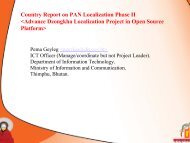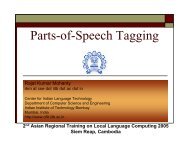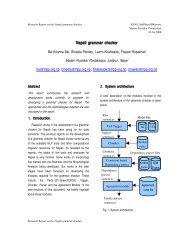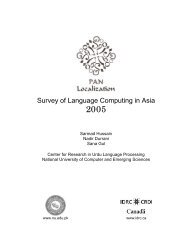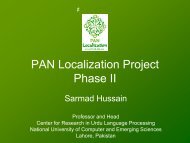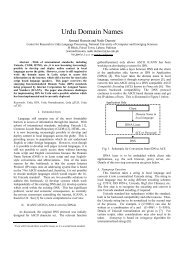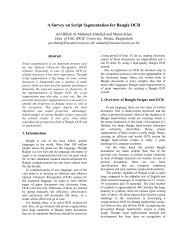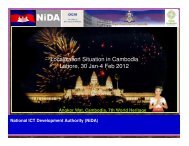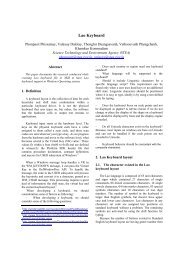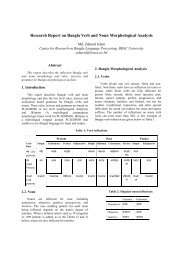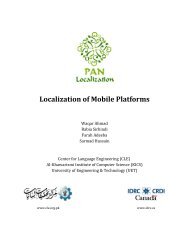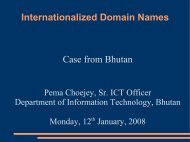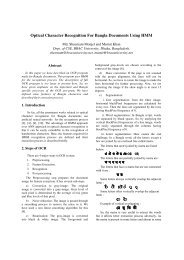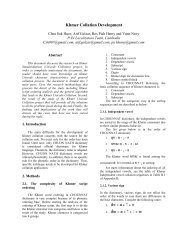Text To Speech for Bangla Language using Festival
Text To Speech for Bangla Language using Festival
Text To Speech for Bangla Language using Festival
You also want an ePaper? Increase the reach of your titles
YUMPU automatically turns print PDFs into web optimized ePapers that Google loves.
<strong>Text</strong> <strong>To</strong> <strong>Speech</strong> <strong>for</strong> <strong>Bangla</strong> <strong>Language</strong> <strong>using</strong> <strong>Festival</strong><br />
Firoj Alam, Promila Kanti Nath and Mumit Khan<br />
BRAC University, <strong>Bangla</strong>desh<br />
firojalam04@yahoo.com, bappinath@hotmail.com, mumit@bracuniversity.net<br />
Abstract<br />
In this paper, we present a <strong>Text</strong> to <strong>Speech</strong> (TTS)<br />
synthesis system <strong>for</strong> <strong>Bangla</strong> language <strong>using</strong> the opensource<br />
<strong>Festival</strong> TTS engine. <strong>Festival</strong> is a complete<br />
TTS synthesis system, with components supporting<br />
front-end processing of the input text, language<br />
modeling, and speech synthesis <strong>using</strong> its signal<br />
processing module. The <strong>Bangla</strong> TTS system proposed<br />
here, creates the voice data <strong>for</strong> festival, and<br />
additionally extends festival <strong>using</strong> its embedded<br />
scheme scripting interface to incorporate <strong>Bangla</strong><br />
language support. <strong>Festival</strong> is a concatenative TTS<br />
system <strong>using</strong> diphone or other unit selection speech<br />
units. Our TTS implementation uses two different<br />
kinds of these concatenative methods supported in<br />
<strong>Festival</strong>: unit selection and multisyn unit selection.<br />
The modules of such a TTS system are described in<br />
this paper, followed by an evaluation of the quality of<br />
synthesized speech <strong>for</strong> acceptability and intelligibility.<br />
1. Introduction<br />
The next step in the evolution of Human<br />
Computer Interaction (HCI) is the integration of<br />
speech and language technologies enabling users to<br />
carry out spoken dialogue with computers. a <strong>Text</strong> to<br />
<strong>Speech</strong> (TTS) system is the primary component<br />
required to make this happen, opening up a world of<br />
possibilities from empowering the visually<br />
handicapped users to removing the barrier to the<br />
in<strong>for</strong>mation age by the illiterate masses in a country<br />
like <strong>Bangla</strong>desh. <strong>Festival</strong> [1] is a complete TTS<br />
synthesis system, with language modeling, and speech<br />
synthesis engine. The language model supports all<br />
language processing tasks. For example document<br />
analysis, text analysis, and phonological processing.<br />
We used festival to develop <strong>Text</strong> to <strong>Speech</strong> <strong>for</strong> <strong>Bangla</strong><br />
language by providing language processing parameter<br />
in language model part and recorded speech in speech<br />
engine. In this paper, we describe the methodology and<br />
implementation of a TTS system <strong>for</strong> <strong>Bangla</strong> based on<br />
the <strong>Festival</strong> TTS engine. We also evaluate the TTS <strong>for</strong><br />
<strong>Bangla</strong> and look at future possibilities.<br />
The organization of the paper is as follows.<br />
Section 2 discusses related works. Section 3 discusses<br />
the methodology. Section 4 discusses results. Then<br />
section 5 discusses future implementation. After that in<br />
section 6 we discuss conclusion.<br />
2. Related works<br />
Following are the related works <strong>for</strong> the <strong>Bangla</strong><br />
<strong>Text</strong> <strong>To</strong> <strong>Speech</strong>. Several attempts were made in the<br />
past, where different aspects of a <strong>Bangla</strong> TTS system<br />
were covered [2][3][4][5]. In [2] authors described<br />
about different modules (optimal text selection, G2P<br />
conversion, automatic segmentation tools) in detail<br />
and experiment results of the different module have<br />
shown. In [3], a significant amount of work has been<br />
done <strong>for</strong> developing <strong>Bangla</strong> TTS. Phoneme and<br />
partname (similar to diphone) are used to develop<br />
voice database and ESOLA technique used <strong>for</strong><br />
concatenation. But quality may suffer <strong>for</strong> lack of<br />
smoothness. In [4] authors showed some practical<br />
applications with <strong>Bangla</strong> TTS system <strong>using</strong> ESNOLA<br />
technique. But per<strong>for</strong>mance of the output not<br />
described. In [5] author showed the pronunciation rule<br />
and phoneme to speech synthesizer <strong>using</strong> <strong>for</strong>mant<br />
synthesis technique. None of them have shown the<br />
naturalness and inteligibility of the system. This work<br />
is done with multisyn unit selection and unit selection<br />
technique within festival framework and per<strong>for</strong>mance<br />
of the intelligibility and naturalness of the system have<br />
shown.<br />
3. Methodology<br />
The TTS <strong>for</strong> <strong>Bangla</strong> uses the widely used <strong>Festival</strong><br />
TTS engine. [1] The different phases of the synthesis<br />
task are per<strong>for</strong>med by several modules as shown in<br />
Figure 1. The text analysis module part converts all<br />
non standard words to standard ones. The phonemic<br />
analysis module is a grapheme-to-phoneme converter,<br />
converting the written text into a sequence of<br />
phonemic symbols. The prosodic analysis module then<br />
takes the phoneme sequence, and assigns to each<br />
phoneme the required pitch and duration. Both the
phonemic and prosodic analyses are typically language<br />
dependent. Then the final the speech synthesis is<br />
per<strong>for</strong>med by <strong>using</strong> two different concatenative<br />
synthesis techniques available in the <strong>Festival</strong> engine –<br />
unit selection and multisyn unit selection. We<br />
implemented all the modules <strong>using</strong> <strong>Festival</strong> tools.<br />
Detecting stress on<br />
syllable and word level.<br />
3.1. <strong>Text</strong> analysis<br />
<strong>Text</strong><br />
⌨ <br />
<strong>Text</strong> Analysis<br />
(Converting Abbreviation,<br />
Number, Dates)<br />
Phonetic analysis<br />
Grapheme to phoneme<br />
Conversion<br />
(Using pronunciation lexicon<br />
and letter to sound Rule)<br />
Stress<br />
Prosodic Analysis<br />
Phrase, Sentences<br />
Intonation<br />
Wave<strong>for</strong>m Synthesis<br />
Synthesizing of <strong>Speech</strong><br />
Concatenating of speech Unit<br />
<strong>Speech</strong> Output <br />
Figure 1: Architecture of TTS<br />
Detecting punctuation marks<br />
and grammatical words<br />
The first step of <strong>Text</strong> to <strong>Speech</strong> system is text<br />
analysis [6] that means analysis of raw text into<br />
pronounceable word. It involves the work on the real<br />
text, where many Non-Standard Word (NSW) [7]<br />
representations appear, <strong>for</strong> e.g., numbers (year, time,<br />
ordinal, cardinal, floating point), abbreviations,<br />
acronyms, currency, dates, URLs. All of these nonstandard<br />
representations should normalize, or in other<br />
words convert to standard words. These NSW should<br />
normalize <strong>using</strong> text normalization and ambiguous<br />
token should disambiguate <strong>using</strong> rules.<br />
3.1.1. <strong>Text</strong> analysis part in <strong>Festival</strong>. <strong>Festival</strong> does<br />
not support Unicode directly, so in the first step we<br />
transliterated our Unicode text to ASCII code<br />
according <strong>Bangla</strong> phone set [8]. The transliteration<br />
table is given in table-1. In our system of text analysis<br />
parts we worked on standard words. We identified<br />
more than 10 types of NSW in <strong>Bangla</strong> <strong>Language</strong>,<br />
which in not implemented yet. Some example of NSW<br />
in <strong>Bangla</strong> <strong>Language</strong> is given in table 2 that can be<br />
implemented in future. Now our system only supports<br />
Unicode, not ASCII coded <strong>Bangla</strong> text. As most of the<br />
existing <strong>Bangla</strong> text is written in ASCII code, so we<br />
have a plan to implement it later.<br />
Table 1: <strong>Bangla</strong> to ASCII transliteration table 1<br />
Letter<br />
Transliteration<br />
Letter<br />
Transliteration<br />
Letter<br />
Transliteration<br />
Letter<br />
Transliteration<br />
Letter<br />
Transliteration<br />
a a ou jh da r<br />
å aa к k nio dh l<br />
i i х kh a t n ш sh<br />
и ii g th p sh<br />
u u gh d ph s<br />
uu ng dh b h<br />
e e c n bh y<br />
oi ch ta m ra<br />
o o j to z ra<br />
3.1.2. Steps of text analysis in <strong>Festival</strong>. The steps <strong>for</strong><br />
text analysis in <strong>Festival</strong> are as follows.<br />
Step 1: Split the token: We can split our token based<br />
on white-space and punctuation.<br />
• White-space can be viewed as separators.<br />
• Punctuation can separate the raw tokens.<br />
• <strong>Festival</strong> converts text into: Ordered list of<br />
tokens, each with features of white-space, and<br />
punctuation.<br />
NSW<br />
Category<br />
Cardinal<br />
number<br />
Table 2: NSW categories<br />
Written<br />
<strong>for</strong>mat<br />
9 5 6 7 4<br />
4 7<br />
Pronunci<br />
ation<br />
<br />
<br />
<br />
IPA<br />
transcripti<br />
on<br />
noj p˜ac<br />
cʰɔj sat̪<br />
1 <strong>Bangla</strong> Script has some other characters that are not<br />
included here; also they are not phones but modify<br />
sound.
cʰar sat̪<br />
Ordinal 1 p<br />
number<br />
prɔt̪ʰɔm<br />
Date 02/06/06 di di d̪ui ɟun d̪ui<br />
<br />
haɟar cʰɔj<br />
Time 4:20 : a ш cʰarta biʃ<br />
a<br />
minit<br />
Ratio 1:2 eк a ek ɔnupat̪<br />
di<br />
d̪ui<br />
Special aк<br />
character<br />
taka<br />
Acronym daka<br />
<br />
biʃʃɔbid̪d̪al<br />
<br />
ɔj<br />
Abbreviati<br />
on<br />
doctor<br />
White-space is the most commonly used delimiter<br />
between words and is extensively used <strong>for</strong><br />
tokenization. But <strong>using</strong> white-space as the only<br />
delimiter have some limitation: a token type which<br />
allows the occurrence of white-space within the token<br />
will not recognize as a single token, but split up into<br />
two or more tokens. For example, consider a telephone<br />
number 880 2 9 5 6 7 4 4 7 [880 2 9567447] IPA .<br />
This can identify as a single token of type ‘telephone<br />
number', but if tokenization is exclusively based on<br />
white-space, then we end up having 3 tokens. Further,<br />
an important limitation is that every token will then<br />
have to go through a token identification process that<br />
identifies its token type/category.<br />
Step 2: (Type identifier) As we explained <strong>Bangla</strong><br />
<strong>Language</strong> have more than 10 types of NSW, so each<br />
NSW can identify as separate token by token identifier<br />
rules. <strong>To</strong> identify the token we can use scheme regular<br />
expression in festival, which is not implemented yet.<br />
There is also an ambiguity in abbreviation, and<br />
number in <strong>Bangla</strong> language. We use colon [:] <strong>for</strong><br />
abbreviation as well as middle of two sentences. For<br />
example, :<br />
o 1 4 4 <br />
<br />
। : [], å: []<br />
ʃikkha prot̪iʃtan bond̪o: lagat̪ar hɔrtal o 144 d̪arar<br />
karɔne kanʃater silpɔ prot̪iʃtangulo bond̪o rojeche. d:<br />
(dɔktɔr), a: (abdul)<br />
Number/phone number: 9567443 [9567447] IPA . In this<br />
case we can’t exactly tell whether this is phone number<br />
or number.<br />
Step 3: <strong>To</strong>ken expander: After identification of all<br />
NSW we can convert these to standard word by<br />
pronunciation lexicon or (letter to sound) LTS rule.<br />
3.2. <strong>Text</strong> analysis<br />
The second step of TTS system is to convert the<br />
text to its pronunciation <strong>for</strong>m. For example we write<br />
k [к+◌+++◌] [k+virama+s+m+a], but we<br />
pronounce it х [k h ɔma]. For finding pronunciation of<br />
a word we need large list of lexicon and LTS rule. We<br />
used lexicon dictionary that contain 900 lexicons with<br />
its pronunciation.<br />
Steps of Phonetic Analysis within festival:<br />
1. Building large amount of lexicon.<br />
2. Building letter-to-sound rules.<br />
3.2.1. Building large amount of lexicon by hand.<br />
We included a lexicon with 900 entries<br />
programmatically <strong>using</strong> the embedded Scheme<br />
interpreter. Developing the Letter-to-Sound (LTS )<br />
rule <strong>for</strong> <strong>Bangla</strong> language however proved to much too<br />
difficult <strong>for</strong> this stage, so it is left <strong>for</strong> a future<br />
implementation. Also, <strong>using</strong> the LTS rules is much<br />
more computationally intensive, <strong>Festival</strong> engine<br />
prefers an elaborate lexicon instead. We implemented<br />
our pronunciation lexicon by scheme within festival.<br />
The <strong>Festival</strong> TTS engine assumes that we have a<br />
large lexicon when building a voice. The lexicon<br />
contains not just the phonemic representation of each<br />
entry, but also the syllabic structure and other<br />
annotations such as part of speech tags, stress markers,<br />
etc. <strong>Festival</strong> uses the attributes of each entry to<br />
synthesize its pronunciation. We implemented our<br />
large set of lexicon based on <strong>Bangla</strong> syllabic structure.<br />
The syllable structure [9] of <strong>Bangla</strong> <strong>Language</strong> is V,<br />
VC, VV, CV, CVC, CVV, CCV, CCVC. An example<br />
lexicon <strong>for</strong>mat in festival is (“aapni” n (((aa p ) 0) ((n<br />
i) 0) )) → [apni] IPA<br />
3.2.2. Building letter-to-sound rules. <strong>Bangla</strong><br />
language always borrows words from other languages<br />
like computer (к -kɔmputar),<br />
competition ( - kɔmpitiʃɔn). <strong>To</strong> find<br />
the pronunciation of new arrival words that is not<br />
found in the lexicon we have to use LTS rule. The<br />
LTS, also called the Grapheme-to-phoneme (G2P),<br />
rules can be specified in <strong>Festival</strong> in two ways: by
providing <strong>Festival</strong> the handcrafted rules, and by<br />
building the rules automatically. Having a proper LTS<br />
rule-set obviates the need <strong>for</strong> an explicit lexicon in<br />
<strong>Festival</strong>; however, the difficulty in building LTS <strong>for</strong> a<br />
language like <strong>Bangla</strong>, and the associated<br />
computational complexity in interpreting these rules,<br />
make having an explicit lexicon much more<br />
convenient. In practice, both are used – the lexicon<br />
with the most frequently found annotated words, and<br />
the LTS rules <strong>for</strong> the rest. We used some of the LTS<br />
rule in our implementation based on our syllabification<br />
rule.<br />
3.3. <strong>Speech</strong> Database / Wave<strong>for</strong>m Synthesis<br />
This <strong>for</strong>ms the core of the TTS “backend” that is<br />
language independent by design. The first step in the<br />
concatenative synthesis is to translate text to the<br />
corresponding labeled phonemes, along with the<br />
various attributes such as stress and emphasis markers<br />
and phrase break tags. The next step takes this<br />
in<strong>for</strong>mation and produces the target prosodic patterns,<br />
which is then processed through various steps to<br />
produce the output utterances. [10][11]<br />
Concatenative synthesis techniques give the most<br />
natural sound in speech synthesis. Three techniques<br />
are available in concatenative synthesis: diphone, unit<br />
selection and multisyn-unit selection. Diphone based<br />
systems sound “wooded”, i.e., unnatural, even if it’s<br />
quite intelligible to native speakers. Unit selection<br />
produces more “natural” sounding speech, so it has an<br />
advantage over the diphone concatenation. Another<br />
advantage of unit selection systems is that the database<br />
can be created automatically. [12] We used unit<br />
selection and multisyn unit selection technique [13] <strong>for</strong><br />
wave<strong>for</strong>m synthesis. <strong>To</strong> implement speech database<br />
<strong>using</strong> festival at first we have to identify all the<br />
features of the phonemes and total number of phones.<br />
It can be done by articulatory technique or acoustic<br />
technique. Acoustic technique is the best way to<br />
identify all the phoneme of a language. We identified<br />
45 phones excluding 31 diphthongs with their features<br />
[14] based on articulatory analysis. <strong>To</strong> build diphone<br />
database we have to include diphthong as well. In our<br />
implementation we excluded the diphthongs.<br />
As we explained earlier we added lexicon <strong>for</strong><br />
pronunciation of words. Also duration of the each<br />
phone is added to implement the TTS <strong>for</strong> <strong>Bangla</strong>. The<br />
duration we added is taken from Kiswahili [15] TTS<br />
system. This is not exact duration <strong>for</strong> the phone set of<br />
<strong>Bangla</strong> language. Using acoustic analysis procedure<br />
we can measure exact duration of the phone set.<br />
4. Results<br />
The drawback of unit selection and multisyn unit<br />
selection is that a large set of speech corpus is required<br />
to develop speech database. Approximately 500-900<br />
recorded utterance is better to cover most frequent<br />
words of language. In our implementation we recorded<br />
sentences and trained the system in both techniques.<br />
When train the system internally festival break its unit<br />
by diphone. Diphone is the combination of two phones<br />
that is at the middle of one phone to the middle of next<br />
phone. <strong>Festival</strong> breaks the signal at zero crossing<br />
position as shown in figure 2. When the system<br />
synthesizes the voice its try to match this position<br />
that’s why there is lack of signal distortion and the<br />
produced sound is quite natural.<br />
Figure 2: Splitting at the zero crossing position<br />
Here we have shown the results based on the<br />
limited domain technique. The per<strong>for</strong>mance we gained<br />
from multisyn technique is 30% poor than limited<br />
domain technique. There were two metrics used to<br />
evaluate the system – acceptability/naturalness and<br />
intelligibility – under laboratory conditions. In our first<br />
experiment, intelligibility of synthesized speech was<br />
evaluated on three levels: sentence level, word level<br />
and phrase level based on the trained corpus. Each<br />
participant was asked to write down everything they<br />
heard. Figure 3 gives the percentage of correctly<br />
understood sentences, words and phrase. In case of<br />
sentences level the intelligibility rate being close to<br />
85%. On phrase level it is 83.33% and word level it is<br />
56.66%.<br />
In our second experiment, degree of naturalness of<br />
the synthesized speech was assessed, again on sentence<br />
90%, phrase 85% and word level 65%. The results<br />
obtained are shown in Figure 4. Despite a rather good<br />
naturalness of synthetic speech, utterances sometimes<br />
suffer a lack from intelligibility.
100<br />
85 83.33<br />
80<br />
60<br />
56.66<br />
40<br />
20<br />
0<br />
Sen Phrase Word<br />
intelligibility (Avg of 3 observation)<br />
Figure 3: Intelligibility of pronunciation<br />
impaired and those who cannot read <strong>Bangla</strong> access to<br />
<strong>Bangla</strong> electronic content such as the World Wide<br />
Web. We have described a proof-of-principle<br />
implementation of a <strong>Bangla</strong> TTS, and there is much<br />
work to be done be<strong>for</strong>e we have a complete and<br />
commercial quality TTS system such as those<br />
available <strong>for</strong> many other languages. We have a plan to<br />
continue developing the <strong>Bangla</strong> festival voice to<br />
improve the quality of the synthesized speech. The<br />
synthetic speech produced by the system is intelligible,<br />
but lacks of naturalness. Improvement of intelligibility<br />
and naturalness depend on significant amount of work<br />
in each phase.<br />
100<br />
80<br />
60<br />
40<br />
20<br />
90<br />
85<br />
65<br />
7. References<br />
[1] A. Black, P. Taylor, “The <strong>Festival</strong> <strong>Speech</strong><br />
Synthesis System”, Technical Report HCRC/TR-83,<br />
University of Edinburgh, Scotland, 1997,<br />
http://www.cstr.ed.ac.uk/projects/festival.html.<br />
0<br />
Sen Phrase Word<br />
[2] T. Sarkar, V. Keri, M. Santhosh and K. Prahallad,<br />
“Building Bengali Voice Using Festvox”, ICLSI 2005.<br />
naturalness (Avg of 3 observation)<br />
Figure 4: Naturalness of pronunciation<br />
5. Future Implementation<br />
A number of plans are made to develop the<br />
complete TTS system <strong>for</strong> <strong>Bangla</strong> language including<br />
the following: Document Analysis (to analyze file<br />
type, file <strong>for</strong>mat, encoding, etc), <strong>Text</strong> Analysis (text<br />
analysis/normalization <strong>using</strong> scheme or java or C++<br />
<strong>for</strong> larger context), Phonetic Analysis (proper acoustic<br />
analysis on <strong>Bangla</strong> phone set, developing large number<br />
pronunciation lexicon, automatic lexicon entries<br />
instead of adding manually, find out LTS or<br />
Grapheme-to-Phoneme (G2P) rule so that it can handle<br />
unknown words), Prosody Analysis, and Wave<strong>for</strong>m<br />
synthesis by diphone technique.<br />
6. Conclusion<br />
The described speech synthesis system is the open<br />
source and freely distributable TTS system <strong>for</strong> <strong>Bangla</strong><br />
language. This is the complete process to develop<br />
commarcial TTS system which includes most of the<br />
complexity of <strong>Bangla</strong> language. Besides the obvious<br />
uses of a TTS system, from listening to computerized<br />
books to ones email, it also allows the visually<br />
[3] A. Bandyopadhyay, “Some Important Aspects of<br />
Bengali <strong>Speech</strong> Synthesis System” IEMCT, Pune, June<br />
24-25, 2002.<br />
[4] S.K.D. Mandal and B. Pal “Bengali <strong>Text</strong> to <strong>Speech</strong><br />
Synthesis System: A Novel Approach <strong>for</strong> Crossing<br />
Literacy Barrier”, CSI-YITPA(E), 2002<br />
[5] A. Sen, “<strong>Bangla</strong> Pronunciation Rules and a <strong>Text</strong>to-<strong>Speech</strong><br />
System”, Symposium on Indian<br />
Morphology, Phonology & <strong>Language</strong> Engineering,<br />
2004, pp. 39.<br />
[6] K. Panchapagesan, P.P Talukdar, N.S. Krishna, K.<br />
Bali and A.G. Ramakrishnan, “Hindi <strong>Text</strong><br />
Normalization”, Fifth International Conference on<br />
Knowledge Based Computer Systems (KBCS),<br />
Hyderabad, India, 2004.<br />
[7] R. Sproat, A. Black, S. Chen, S. Kumar, M.<br />
Ostendorf and C. Richards, “Normalization of Nonstandard<br />
Words”, Computer <strong>Speech</strong> and<br />
<strong>Language</strong>, vol. 15, 2001, 287-333.<br />
http://www.clsp.jhu.edu/ws99/projects/normal/slides/i<br />
ntro/nswintro.pdf<br />
[8] Bengali script – Wikipedia, the free encyclopedia,<br />
http://en.wikipedia.org/wiki/Bengali_script
[9] M.D.A. Hay, Dhani Biggan.<br />
[10] P. Zervas, I. Potamitis, N. Fakotakis, G.<br />
Kokkinakis, “A Greek TTS Based on Non Uni<strong>for</strong>m<br />
Unit Concatenation and the Utilization of <strong>Festival</strong><br />
Architecture”, First Balkan Conference on<br />
In<strong>for</strong>matics, Thessalonica, Greece, 2003, pp. 662-668.<br />
[11] A. Conkie, “Robust Unit Selection System For<br />
<strong>Speech</strong> Synthesis”, The Journal of the Acoustical<br />
Society of America, Volume 105, Issue 2, February<br />
1999, pp. 978.<br />
[12] R. Clark, K. Richmond and S. King, “<strong>Festival</strong> 2 –<br />
Build Your Own General Purpose Unit Selection<br />
<strong>Speech</strong> Synthesizer”, 5th ISCA Workshop on <strong>Speech</strong><br />
Synthesis, 2004, pp. 173<br />
[13] R. Clark, Multisyn Unit selection technique,<br />
http://www.cstr.ed.ac.uk/downloads/festival/multisyn_<br />
build, Unit selection technique, www.festvox.org.<br />
[14] N. Khan, D. Haque, B.B. Kotha, A. Hai and<br />
D.B.O. Dhanitotto, “Phoneme set and their features”,<br />
CRBLP.<br />
[15] Kiswahili TTS system, www.llsti.org.



